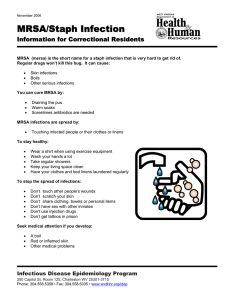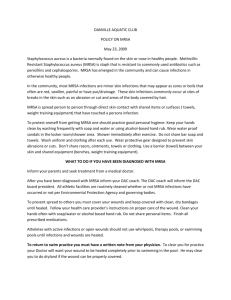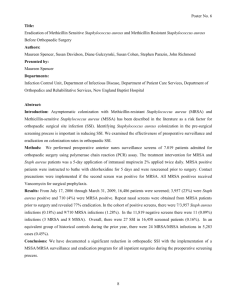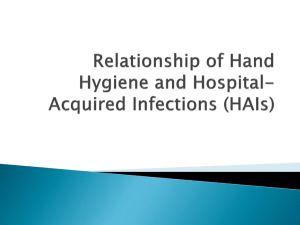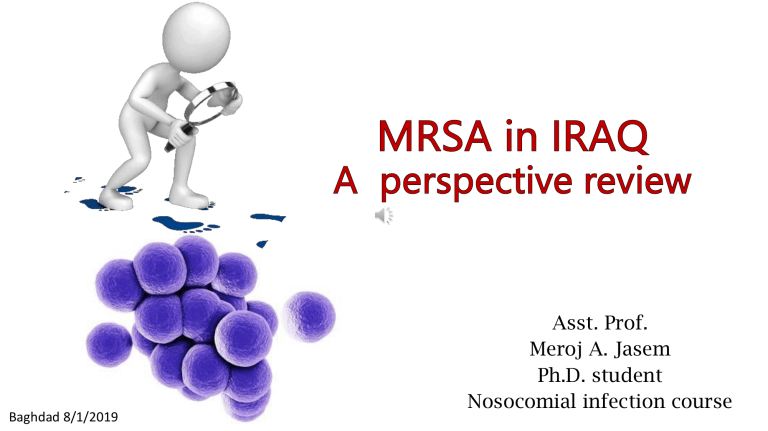
Baghdad 8/1/2019 Asst. Prof. Meroj A. Jasem Ph.D. student Nosocomial infection course • S.aureus is an opportunistic bacterium, normally, part of the human microflora but, attacks immediately when the immune system of the host becomes susceptible. • Even though S.aureus can be found in different parts of the body but anterior nares are the principal ecological sites in humans. • A study had reported nasal carriage as a major risk factor for S.aureus infection that differs from person to person. • It had been reported that 20% of the healthy individuals carry S.aureus persistently, 60% intermittently and 20% never carry S.aureus. • Staphylococcus aureus is universal in distribution found in pus, boils, abscess, skin, throat, nasophrynx, oral mucosa, soil, sewage, milk and water. • Gram Positive • Non-motile • Spherical • Grows in clumps • Resembles clumps of grapes • Golden color- colonies • Some produce hemolysis • Some produces coagulase • Produce catalase enzymes was with oxacillin the new line of penicillins in 1959, which became a new hope to the treatment of St. aureus. In 1961 the St. aureus became resistant to methicillin. Strains that are oxacillin and methicillin resistant, historically termed Methicillin-Resistant S.aureus (MRSA). • are penicillin-binding proteins. They are responsible for the final stages of peptidoglycan synthesis of the bacterial cell wall structure. Inhibition of one or more of these essential enzymes leads to bacterial lysis. • are the antibiotics that contain the beta lactam ring. These are: penicillins, cephamycins, cephalosporins, carbapenems monobactams. The ring structure is common to all beta-lactams and must be intact for antibacterial action. They are cell wall synthesis inhibitors. • are enzymes that catalyse the hydrolysis of the beta-lactam ring and inactivate these group of antibiotics. Genes encoding these enzymes are widespread in the bacteria. • MRSA is a type of staph bacteria that has become resistant to methicillin and other antibiotics commonly used to treat staph infections • MRSA stands for: M ethicillin R esistant S taphylococcus a ureus • MRSA infections can range from very minor to life-threatening • MRSA bacteria can live on surfaces for several days • Since the 1960s, methicillin-resistant Staphylococcus aureus (MRSA) has emerged, disseminated globally and become a leading cause of bacterial infections in both health-care and community settings. • Different MRSA clones have resulted from the independent acquisition of staphylococcal cassette chromosome mec A (SCCmec), which contains genes encoding proteins that render the bacterium resistant to most βlactam antibiotics (such as methicillin), by several S. aureus clones. • The success of MRSA is a consequence of the extensive arsenal of virulence factors produced by S. aureus combined with β-lactam resistance and, for most clones, resistance to other antibiotic classes. • Clinical manifestations of MRSA range from asymptomatic colonization of the nasal mucosa to mild skin and soft tissue infections to fulminant invasive disease with high mortality. • The type (t932/SCCmec III) is the predominant isolates in IRAQ according to a molecular characterization study conducted in three different Arab countries including IRAQ . • The results also indicate the geographical spread of MRSA over long distances and across cultural borders. Thus, continuous surveillance of MRSA in hospitals and communities is of great importance for understanding the epidemiology of MRSA. Staphylococcus aureus virulence molecules. • AhpCF, alkyl hydroperoxide reductase subunits C and F; Aur, aureolysin; BsaA, glutathione peroxidase; CHIPS, chemotaxis inhibitory protein of staphylococcus; Clf, clumping factor; Cna, collagen adhesin; Coa, coagulase; CPS, capsule; Eap, extracellular adherence protein; Efb, extracellular fibrinogen binding protein; FLIPr, formyl peptide receptor-like 1 inhibitory protein; fMLP, N-formyl-methionyl-leucyl-phenylalanine; FnBPAB, fibronectin binding protein A and B; Hla, αhemolysin; HlgABC, gamma-hemolysin subunits A, B, and C; IcaADBCR, intercellular adhesin subunits A, D, B, C, and R; Isd, iron-regulated surface determinant; KatA, catalase; LTA, lipoteichoic acid; Luk, leukocidin; MprF, multiple peptide resistance factor; OatA, O-acetyltransferase A; PSM, phenolsoluble modulin; PVL, Panton-Valentine leukocidin; ROS, reactive oxygen species; Sak, staphylokinase; Sbi, staphylococcal IgG-binding protein; SCIN, staphylococcal complement inhibitor; SdrCDE, Ser-Asp rich fibrinogen/bone sialoprotein-binding protein subunits C, D, and E; SE, staphylococcal enterotoxin; SOD, superoxide dismutase; Spa, staphylococcal protein A; SSL, staphylococcal superantigen-like protein; SXN, staphyloxanthin; TrxAB, thioredoxin (TrxA) and thioredoxin reductase (TrxB); vWbp, von Willebrand factor binding protein; WTA, wall techoic acid. Figure 1 Worldwide prevalence of MRSA 31/5/2018 Nature Reviews Disease Primers Data represented are adapted from the Center for Disease Dynamics, Economics & Policy Resistance Map; data for the following countries are adapted from Stefani, S. et al. Meticillin-resistant Staphylococcus aureus (MRSA): global epidemiology and harmonisation of typing methods. Int. J. Antimicrob. Agents 39, 273–282 (2012), Elsevier: Algeria, Bolivia, Brazil, Cameroon, Central African Republic, Chile, Colombia, Egypt, Hong Kong, Indonesia, Ivory Coast, Japan, Kenya, Malta, Morocco, Nigeria, Paraguay, Peru, Senegal, Singapore, South Korea, Sri Lanka, Tunisia and Uruguay Lee, A. S. et al. (2018) Methicillin-resistant Staphylococcus aureus Nat. Rev. Dis. Primers doi:10.1038/nrdp.2018.33 Nature Reviews Disease Primers • HA-MRSA Healthcare (Hospital )- acquired MRSA • CA-MRSA Community-acquired MRSA • LA-MRSA Livestock-acquired MRSA According to the CDC certain conditions make the transfer of MRSA easier. They call this the 5 C’s risk factors. Crowding Un-controlled Antimicrobial Use Compromised Skin Contaminated Surfaces and Shared Items Frequent contact Cleanliness 14% 86% Community-Associated Healthcare-Associated Klevens et al JAMA 2007;298:1763-71 ., • Being hospitalized. MRSA remains a concern in hospitals, where it can attack those most vulnerable — older adults and people with weakened immune systems. • Having an invasive medical device. Medical tubing — such as intravenous lines or urinary catheters — can provide a pathway for MRSA to travel into your body. • Residing in a long-term care facility. MRSA is prevalent in nursing homes. Carriers of MRSA have the ability to spread it, even if they're not sick themselves. • Surgery • Devices used in invasive procedures • ICU or burn ward • Age • Treatment with multiple antibiotics • Severe illness or disability • Prolonged or repeated hospital stays • Compromised immune system • Skin infections include impetigo, folliculitis, carbuncles, styes or boils. • Other skin infections include furuncles and abscesses can begin as painful red papules with surrounding erythema and can develop necrotic centers. • Abscesses, pustular lesions, “boils” • “Spider bites” • Cellulitis • More serious problems include penetration beyond cutaneous and soft tissue manifestations • e.g. pneumonia, deep abscesses, osteomyelitis, endocarditis, phlebitis, mastitis, and/or meningitis) • Atypicals include toxic shock syndrome, bacteremia, endocarditis, pneumnoia, osteomyelitis, necrotizing fasciitis • MRSA should also be considered in differential diagnosis of severe disease compatible with S. aureus infection: • Osteomyelitis • Necrotizing pneumonia • Septic arthritis • Endocarditis • Sepsis syndrome • Necrotizing fasciitis • Although treatment options for MRSA are limited, several new antimicrobials are under development. • An understanding of colonization dynamics, routes of transmission, risk factors for progression to infection and conditions that promote the emergence of resistance will enable optimization of strategies to effectively control and treatment of MRSA. • Vaccine candidates are also under development and could become an effective prevention measure. • New treatments with honey and maggots • Groups are questioning the benefit of circumcision when s.aureus presence in hospitals is increasing • Can MRSA be a sexually transmitted infection? • Streptococcus has historically been causative organism for ‘flesh eating disease’ infections, yet new research shows S.aureus cultured from such wounds Thank you
